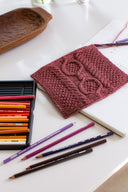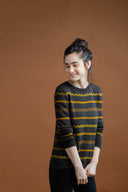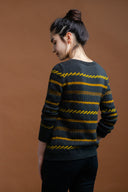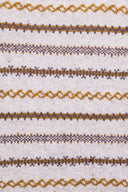Ashland
Pattern Specs
CONSTRUCTION
- The body and sleeves are worked circularly to the underarms. Stitches are bound off for the underarms, and new stitches cast on for steeks, so that work may continue circularly on the yoke and sleeve caps. The steeks are worked over 5 stitches, alternating colors every stitch on two-color rounds, creating vertical stripes; for the rounds on which only C1 is used, the steeks are worked in C1 (not striped). It does not matter which color is worked first on the striped rounds; the steeks will not be seen once the garment is assembled. The garment is blocked with the steeks uncut. Please note that the steeks are not shown on the schematic. The steeks are cut before sewing the shoulder seams and setting in the sleeves.
FINISHED DIMENSIONS
- 35¼ (39, 43, 46¾, 50½, 54½)” [89.5 (99, 109, 118.5, 128.5, 138.5) cm] circumference at chest
- Samples shown is size 39″ [99 cm] with + 5″ [12.5 cm] ease on models
Need help picking a size? See our resource page on Selecting a Sweater Size 101.
GAUGE
- 25 stitches & 34 rounds = 4″ in Ashland pattern from chart with Size A/Size B needle(s), after blocking
NEEDLES
Size A (for Single-Color Rounds of Main Fabric)
- One each 24″ and 32″ circular needles and one set of double-pointed needles (DPNs) in size needed to obtain gauge listed
- Suggested Size: 3¾ mm (US 5)
Size B (for Two-Color Rounds of Main Fabric)
- One each 24″ and 32″ circular needles and one set of double-pointed needles (DPNs) one size larger than Size A
- Suggested Size: 4 mm (US 6)
Size C (for Ribbing)
- One each 16″ and 32″ circular needles and one set of double-pointed needles (DPNs) one size smaller than Size A
- Suggested Size: 3½ mm (US 4)
Size D (optional; for Tubular Cast On and Bind Off only)
- One each 16″ and 32″ circular needles and one set of double-pointed needles (DPNs) two sizes smaller than Size A
- Suggested Size: 3¼ mm (US 3)
Please note: the stitch patterns in this garment are charted only.
Pattern Materials
YARN
Loft Version
Brooklyn Tweed Loft (100% American Targhee-Columbia wool; 275 yards/50 grams)
- 5 (5, 6, 6, 7, 7) skeins of Color 1 (C1)
- 1 (1, 1, 2, 2, 2) skein(s) of Color 2 (C2)
- 1 (1, 1, 1, 2, 2) skein(s) of Color 3 (C3)
- Sample photographed in colors Fossil (C1), Hayloft (C2), and Truffle Hunt (C3)
Peerie Version
Brooklyn Tweed Peerie (100% American Merino Wool; 210 yards/50 grams)
- 6 (6, 7, 8, 8, 9) skeins of C1
- 1 (1, 1, 2, 2, 2) skein(s) of C2
- 1 (1, 1, 1, 1, 2) skein(s) of C3
- Sample photographed in colors Humpback (C1), Tincture (C2), and Burnished (C3)
YARDAGE
Loft Version
Fingering weight wool yarn in the following amounts:
- 1160 (1270, 1420, 1560, 1720, 1865) yards Color 1 (C1)
- 195 (210, 240, 265, 295, 320) yards Color 2 (C2)
- 175 (195, 220, 240, 270, 290) yards Color 3 (C3)
Peerie Version
Fingering weight wool yarn in the following amounts:
- 1125 (1230, 1370, 1490, 1645, 1780) yards of C1
- 165 (180, 200, 215, 240, 260) yards of C2
- 145 (160, 175, 190, 210, 230) yards of C3
Techniques
Tutorials for all special techniques listed below are included in the pattern:
- Speed-Swatching for Circular Knitting
- Color Dominance
- 1×1 Tubular Cast On (Circular Knitting, even number of stitches)
- Garter Stitch Selvedge
- Steeking
- Securing a Steek: Crochet Method
- Securing a Steek: Sewn Method (Machine or Hand)
- Backward Loop Cast On
- Sloped Bind Off 1×1
- Tubular Bind Off
- Kitchener Stitch (Grafting)
Errata
Current Pattern: v2.2 (English) & v1.1 (Norwegian)
21 October 2016:
Version 1.1 On page 8, the following has been corrected: Repeat the Sleeve Increase Round every 12th (10th, 8th, 8th, 6th, 6th) round 4 (7, 12, 4, 18, 13) more times, then every 10th (8th, 6th, 6th, 4th, 4th) round
15 August 2018:
Version 2.1 Redundant sentence deleted on page 14, second paragraph.
19 September 2018:
Version 2.2 On page 10, for “Shape Sleeve and Begin Chart,” the Sleeve Increase Round should read: “Knit 1, M1R, work to last stitch, M1L, knit 1. (2 stitches increased)”

Ashland

Uncompromising Excellence in Every Detail








